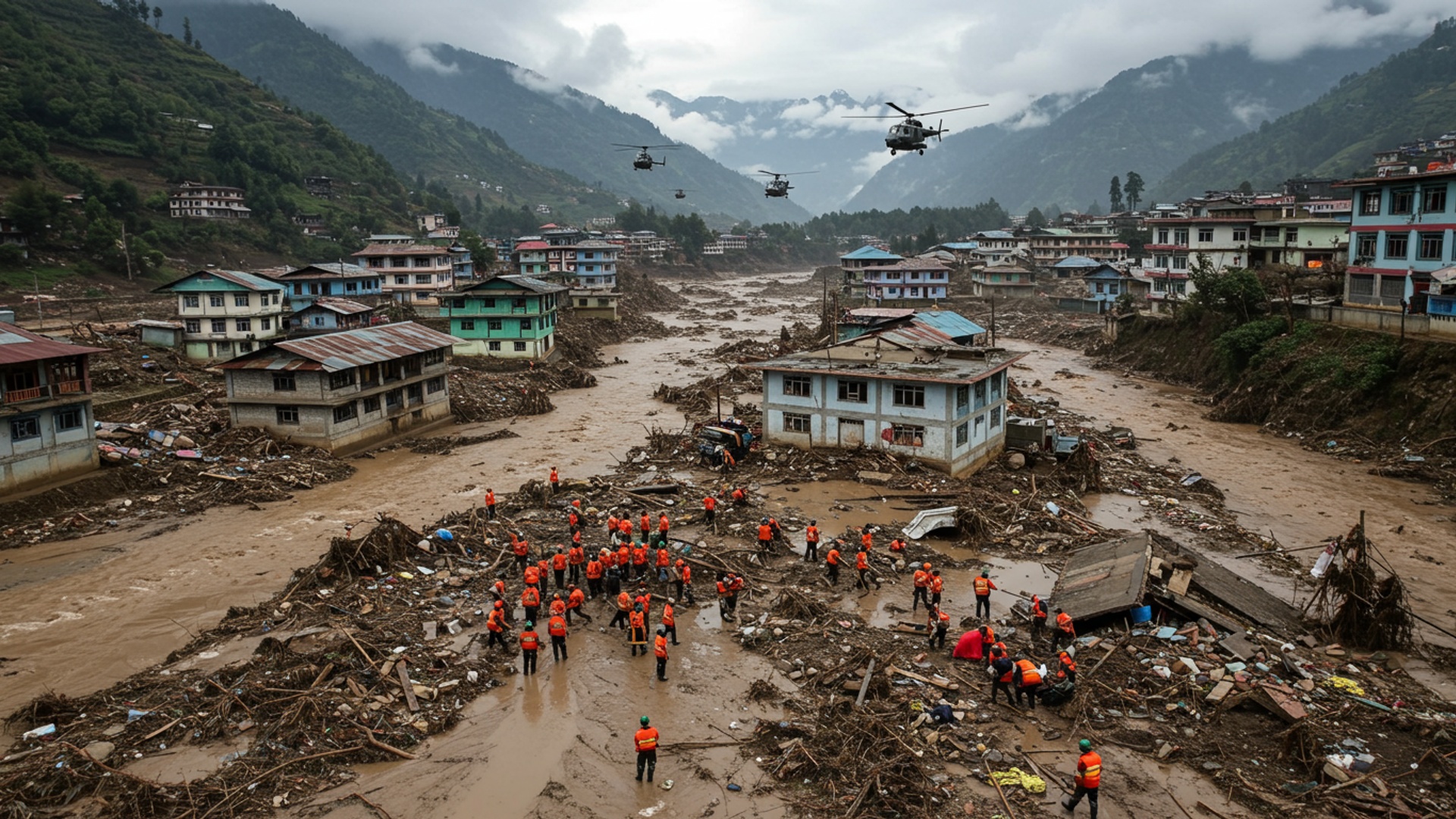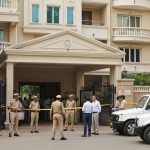Uttarkashi grapples with fresh horror today as search teams race against time to find those swept away by devastating flash floods. Heavy rains unleashed torrents of water through the Himalayan district yesterday, turning serene landscapes into a chaotic disaster zone. Entire villages remain cut off. the desperate search operation intensifies amid mudslides and debris, focusing on remote areas where several people are still unaccounted for. Families wait in agony for news of their loved ones, as the true scale of this sudden natural disaster continues to unfold across the mountainous region. Rescue workers face immense challenges, battling treacherous terrain and the constant threat of further landslides, as every passing hour dims hopes for survivors.
A Village Swallowed by Nature’s Fury
On August 5, 2025, the serene Himalayan village of Dharali in Uttarkashi district, Uttarakhand, was hit by a devastating flash flood. The sudden surge of water and mud, which some experts suggest could be due to a cloudburst, a glacial lake outburst flood, a glacier collapse, or a landslide, swept through the Kheer Gad stream and the Bhagirathi river, leaving a trail of widespread destruction.
The force of the flood was immense, engulfing homes, shops. hotels in the bustling market area of Dharali. Reports indicate that virtually half of the village was buried under meters of mud and debris, with some areas covered up to 15 meters deep. This natural disaster not only destroyed physical structures but also severed vital communication lines, as mobile towers and electricity supply were cut off, making it impossible to connect with the outside world in the immediate aftermath.
The disaster also impacted Harsil, a settlement about three kilometers from Dharali, where an army camp suffered damage from another flood-related incident on the same day. The scale of the destruction has left the local community in shock and grappling with the magnitude of the calamity.
The Search for the Missing
In the wake of the devastating floods, a large-scale search and rescue operation was launched. Multiple agencies, including the Indian Army, the National Disaster Response Force (NDRF), the State Disaster Response Force (SDRF). the Indo-Tibetan Border Police (ITBP), along with local administration teams, have been working tirelessly.
The primary focus remains on locating those swept away or buried under the thick layers of mud and rubble. Official figures on the missing have varied as rescue efforts progress. Initially, reports suggested over 100 people were missing. As of August 11-12, the government confirmed that 42 to 43 people remained unaccounted for.
This count includes nine army personnel, several residents of Dharali village, people from nearby areas, one person from Tehri district. others from Bihar, Uttar Pradesh. Nepal. Specifically, 26 Nepali nationals have been identified among the missing, though five of the initially reported 29 Nepali laborers have since been contacted after mobile networks were partially restored. Local residents, But, believe the actual number of missing persons exceeds 60, reflecting the profound despair and uncertainty in the community.
To aid the search, advanced equipment is being used. Experts from the National Geophysical Research Institute (NGRI) launched a search operation using Ground Penetrating Radars (GPR), which can detect human life and anomalies beneath mud and water up to 40 meters deep. Trained sniffer dogs, named ‘Phantom’ and ‘Coco’, are also actively involved, offering a ray of hope by searching for signs of life under the debris.
NDRF Assistant Commandant R. S. Dhapola stated, “This electrical detector gives data about any element buried up to 40 meters. The radar has revealed that people may be buried about eight to 10 feet below the rubble, where debris, several feet high, has accumulated, making removal a challenge.”
Air operations are also crucial, with helicopters like the Indian Army’s MI-17 and Chinook, along with other state choppers, conducting numerous sorties to evacuate stranded individuals and deliver essential supplies.
Challenges Facing Rescue Teams
The rescue operations in Uttarkashi have been severely hampered by the challenging conditions. Incessant rainfall has been a persistent obstacle, causing further landslides and hindering visibility, which often forces the temporary suspension of air and ground search efforts.
Road connectivity remains a major issue. Many roads leading to the affected areas have either collapsed or are blocked by large boulders and thick mud. This has made it difficult for rescue teams and heavy machinery to reach all disaster sites. A critical development has been the completion of a Bailey bridge at Limchagad, which has helped restore a vital link connecting the India-China border with the Gangotri Dham route. This improved connectivity is expected to speed up ground operations and movement into the affected zones.
Despite these challenges, rescue teams are working tirelessly. Heavy machinery units have been deployed to clear massive stones and debris, while State Disaster Response Force personnel are conducting painstaking manual searches through treacherous muck in a desperate bid to find missing villagers. But, the swampy nature of some sites prevents the deployment of heavy machines, requiring manual cleaning and removal of debris.
Support for Affected Communities
The flash floods have had a profound impact on the local population. Many residents have lost their homes and livelihoods. Around 150 people were directly affected, with over 1,200 people successfully evacuated from Dharali and Harsil. While some affected residents have moved to Uttarkashi or Dehradun, about 300 residents have chosen to stay in Dharali, living amidst the ongoing relief operations.
The state government has taken steps to provide immediate assistance. This includes financial support of 5 lakh rupees and free ration for the next six months to each affected family. Essential goods and food items are being delivered to the disaster-affected areas. efforts are underway to ensure their sufficient availability.
Medical teams, including doctors, nursing assistants. combat medics, are providing emergency care at the disaster site and at various transit points. Injured individuals are also receiving medical treatment at army facilities.
The Chief Minister of Uttarakhand, Pushkar Singh Dhami, is personally overseeing the rescue and relief efforts, emphasizing that the top priority is the safe evacuation of every person and ensuring they receive all necessary support.
Ongoing Weather Concerns and Environmental Impact
The weather continues to be a major concern for Uttarkashi and other parts of Uttarakhand. The India Meteorological Department (IMD) has issued red and orange alerts, warning of heavy to very heavy rainfall, thunderstorms. potential lightning until at least August 17. This ongoing inclement weather poses a risk of further landslides and flash floods, complicating existing rescue operations.
Experts point to a broader issue of environmental vulnerability in the Himalayan region. Rapid construction over the past two decades, including settlements on debris-flow fans along streams like Kheer Gad, has reportedly worsened the impact of such floods. There are also concerns that proposed widening of highways in eco-sensitive zones could lead to tree felling, increasing landslide risks.
Climate change is also being highlighted as a factor intensifying these extreme weather events. Scientists explain that warmer atmospheres hold more moisture, leading to more intense and short bursts of rainfall, which in turn cause flash floods and landslides. The region’s steep terrain and narrow river valleys amplify the impact, turning heavy rain into sudden, violent torrents. The lack of real-time weather surveillance and effective early warning systems in many of these vulnerable mountain zones is also a significant concern, making the region more susceptible to such disasters.
![]()










